Rights of survivors, urgent clearance of remnants should be priorities at November meeting
(London, 11 March 2010) – Five children were killed and one injured when a cluster submunition exploded in a village in Lao PDR’s Champasak province on 22 February 2010. The incident highlights the need for urgent action to assist survivors and ensure the clearance of cluster munition remnants when states parties to the treaty banning cluster bombs gather for their first official meeting in the Lao capital, Vientiane, this November, the Cluster Munition Coalition (CMC) said today.
“Children in Lao PDR continue to bear the brunt of accidents from ‘bombies’ left as the deadly legacy of a secret war that ended decades ago,” said Channapha Khamvongsa, Executive Director of Legacies of War, a CMC member organisation that advocates for the removal of unexploded ordnance in Lao PDR. “Accidents like this one occur with sickening regularity in Lao and underline the need for governments to adopt an ambitious plan in November for cleaning up cluster bomb contamination in Lao and elsewhere.”
According to Lao government sources, a group of eight children found a BLU-3 cluster submunition while they were feeding buffalo in rice paddies about 2 km from the village of Ban Noundeng Nue, in the Soukhouma district of Champasak province, near the border with Thailand. The device exploded while the children were playing with it in a hut on stilts in the rice paddies. The blast instantly killed five of the children and injured one, while two who were farther away were not harmed. The US widely used BLU-3 cluster submunitions – also called pineapple bombs because of their resemblance to the fruit – in bombing raids over Lao PDR in the 1960s and 70s.
“If this kind of tragedy happened in the US, there’d be a national outcry,” said Titus Peachey, Director of Peace Education for the Mennonite Central Committee, a CMC member organisation. “The Lao people are doing all they can to deal with a problem they did not create, but much more support is needed. With the First Meeting of States Parties taking place in Lao PDR in November, we have an opportunity like no other to find solutions to this ongoing injustice against the people and communities suffering from this weapon.”
The Lao National Regulatory Authority for the UXO/Mine Action Sector has promised a detailed investigation of the accident, but it will be delayed due to a current backlog of accidents under investigation.
Lao PDR is the most heavily bombed country, per capita, in the world, with 14 out of 17 provinces affected by unexploded ordnance (UXO) left over from a “secret war” waged by the United States against Pathet Lao insurgents four decades ago. From 1964 to 1973, the US led more than 580,000 bombing missions in Lao PDR – equating to a mission every eight minutes, 24 hours a day, over nine years – dropping more than 2 million tons of bombs and blanketing the countryside with some 270 million submunitions.
Known locally as “bombies,” unexploded cluster submunitions are commonplace in Lao PDR and – along with landmines and other explosive remnants of war – continue to claim up to 300 new victims per year, decades after the armed conflict ended. A recent nationwide survey recorded 50,136 UXO casualties between 1963 and 2008, 40 percent of which happened after the bombing ceased, and 26 percent of which were children. In the period of 2004-2007, cluster submunitions were the largest cause of civilian casualties.
Because of the immense scale of cluster bomb devastation in Lao PDR, several non-governmental organisations (NGOs) work with the government to reduce the impact of explosive remnants of war on civilians, by clearing contaminated land and providing mine-risk education and assistance to victims and affected communities. NGOs actively involved in this work in Lao include AAR Japan, COPE National Rehabilitation Centre, Handicap International, Mines Advisory Group and Norwegian People’s Aid.
Cluster bombs also continue to claim civilian lives in neighbouring Cambodia and Vietnam. In Vietnam, a 40-year-old man was killed by a cluster submunition explosion in Quang Tri province on 12 February, leaving behind a wife and six daughters. The CMC urges both countries to follow Lao PDR’s example and sign the Convention on Cluster Munitions to gain access to much-needed victim assistance.
Less than two years since the Convention opened for signature in Oslo in December 2008, a total of 104 countries have signed, and it will take effect on 1 August after reaching 30 ratifications in February. The next milestone will be the First Meeting of States Parties in Lao PDR in November.
The Convention comprehensively bans use, production, and transfer of cluster munitions and sets strict deadlines for stockpile destruction and clearance of contaminated land within eight years and 10 years respectively. In addition, the Convention obliges states to support survivors and affected communities.
The CMC called on all states not currently on board the ban treaty to sign and ratify as soon as possible, and urged countries that have already ratified to step up implementation of their treaty obligations.
For more information on casualties caused by cluster submunitions, landmines and other explosive remnants of war in Lao PDR, please visit the following:
· Landmine Monitor 2009 country chapter on Lao PDR: http://lm.icbl.org/index.php/publications/display?act=submit&pqs_year=2009&pqs_type=lm&pqs_report=lao
· Banning Cluster Munitions: Government Policy and Practice country chapter on Lao PDR:
http://lm.icbl.org/index.php/publications/display?act=submit&pqs_year=2009&pqs_type=cm&pqs_report=lao
CONTACT:
In Washington, DC, Channapha Khamvongsa: +1-202-965-1785; or channapha@legaciesofwar.org
In Pennsylvania, Titus Peachey: +1-717-859-1151; or tmp@mcc.org
In London, Conor Fortune: +44-(0)207-820-0222; or conor@stopclustermunitions.org
NOTES
About cluster bombs
A cluster munition (or cluster bomb) is a weapon containing multiple - often hundreds - of small explosive submunitions or bomblets. Cluster munitions are dropped from the air or fired from the ground and designed to break open in mid-air, releasing the submunitions over an area that can be the size of several football fields. This means they cannot discriminate between civilians and soldiers. Many of the submunitions fail to explode on impact and remain a threat to lives and livelihoods for decades after a conflict.
About the Convention on Cluster Munitions
The Convention on Cluster Munitions bans the use, production, stockpiling and transfer of cluster munitions and requires countries to clear affected areas within 10 years and destroy stockpiles of the weapon within eight. The Convention includes groundbreaking provisions requiring assistance to victims and affected communities. Signed in Oslo in December 2008, it is the most significant international disarmament treaty since the 1997 Mine Ban Treaty banning antipersonnel landmines.
About the Cluster Munition Coalition (CMC)
The CMC is an international coalition of around 350 non-governmental organisations (NGOs) working in 85 countries to encourage urgent action against cluster bombs. The CMC facilitates NGO efforts worldwide to educate governments, the public and the media about the problems of cluster munitions and to urge universalisation and full implementation of the 2008 Convention on Cluster Munitions.
http://www.stopclustermunitions.org/
The following 104 countries have signed the Convention:
Afghanistan, Albania, Angola, Australia, Austria, Belgium, Benin, Bolivia, Bosnia and Herzegovina, Botswana, Bulgaria, Burkina Faso, Burundi, Canada, Cape Verde, Central African Republic, Cameroon, Chad, Chile, Colombia, Comoros, DR Congo, Republic of Congo, Cook Islands, Costa Rica, Côte D'Ivoire, Croatia, Cyprus, Czech Republic, Denmark, Dominican Republic, Ecuador, El Salvador, Fiji, France, Gambia, Germany, Ghana, Guatemala, Guinea, Guinea Bissau, Haiti, The Holy See, Honduras, Hungary, Iceland, Indonesia, Iraq, Ireland, Italy, Jamaica, Japan, Kenya, Lao PDR, Lebanon, Lesotho, Liberia, Liechtenstein, Lithuania, Luxembourg, Madagascar , Malawi, Mali, Malta, Mexico, Republic of Moldova, Monaco, Montenegro, Mozambique, Namibia, Nauru, Netherlands, New Zealand, Nicaragua, Niger, Nigeria, Norway, Palau, Panama, Paraguay, Peru, Philippines, Portugal, Rwanda, Samoa, San Marino, Sao Tomé and Principe, St. Vincent and Grenadines, Senegal, Sierra Leone, Slovenia, Somalia, South Africa, Spain, Sweden, Switzerland, the former Yugoslav Republic of Macedonia, Togo, Tunisia, Uganda, United Kingdom of Great Britain and Northern Ireland, United Republic of Tanzania, Uruguay, Zambia.
Of these, the following 30 countries have ratified the Convention:
Albania (16 Jun 2009), Austria (2 Apr 2009), Belgium (22 Dec 2009), Burkina Faso (16 February 2010), Burundi (25 Sep 2009), Croatia (17 Aug 2009), Denmark (12 February 2010), The Holy See (3 Dec 2008), France (25 Sep 2009), Germany (8 Jul 2009), Ireland (3 Dec 2008), Japan (14 Jul 2009), Lao PDR (18 Mar 2009), Luxembourg (10 Jul 2009), Macedonia (8 Oct 2009), Malawi (7 Oct 2009), Malta (24 Sep 2009), Mexico (6 May 2009), Moldova (16 February 2010), Montenegro (25 January 2010), New Zealand (22 Dec 2009), Nicaragua (6 Nov 2009), Niger (2 Jun 2009), Norway (3 Dec 2008), San Marino (10 Jul 2009), Sierra Leone (3 Dec 2008), Slovenia (19 Aug 2009), Spain (17 Jun 2009), Uruguay (24 Sep 2009), Zambia (12 Aug 2009).
###########################################
Cluster Bombs in Casing
Project Pineapple
Remember, go to Archives for full story at bottom of picture column
SPECIAL UPDATE FOR AMERICANS
FOR NON AMERICANS PLEASE PASS ON TO YOUR US FRIENDS AND CONTACTS
PLEASE VIEW SITE
http://www.handicap-international.us/our-fight-against-landmines-and-cluster-bombs/in-brief/
AND FIND LINK TO
National Senate Call-In Day to Ban Cluster Bombs MAR 30
but keep up the pressure after this date
MAKE SURE YOU CONTACT YOUR SENATOR
ALSO for those who wish to make donations to Handicap International, a co-founder of the International Campaign to Ban Landmines (ICBL) which was awarded the Nobel Peace Prize in 1997, and now widely recognized as a key international lobbyist on weapons of war, please got to:
http://apps.facebook.com/causes/285080?m=96aaaf39
Be sure to contact your political representative too wherever you are.
PROJECT PINEAPPLE INITIATED WITH A MOTORCYCLE RIDE THROUGH INDOCHINA TO PUBLICISE THE CLUSTER BOMB ISSUE.
Laos was carpet bombed along the Vietnam border to wipe out the VietCong's supply lines, the multiple trails known as the Ho Chi Minh Trail. Now, the issue is still being swept under a diplomatic carpet.
The Iraq war opened on 19th March, 2003, with Cluster Bombs being dropped. I was in Laos walking through remote villages on a water well project when I got the news on my short wave radio. Those same villages were carpet bombed 35 years earlier and still living under the threat of 76 million unexploded Cluster Bombs.
Billions of dollars continue to be spent on Iraq but a mere 500 thousand dollars annually on clearing unexploded Cluster Bombs in Laos.
The Vietnam War ended on 30th April 1975 when the last ten marines were choppered out.
I used the Belarusian 125cc Minsk motorcyle to ride from Hanoi, Vietnam, through Laos and Cambodia to Ho Chi Minh City between 19th March and 30th April representing respectively the start of Cluster Bombs being dropped on Iraq and the final withdrawal of US marines from Saigon.
Visits were made to various relevant projects and programs both for clearing unexploded bombs and supporting the victims.
Should you be in any of these countries it is worth
finding out what you can about this 'forgotten' problem. Rural children and adults are still dying and being maimed every day.
Please email any comments to : project.pineapple@yahoo.com
Remember to go to Blog Archives at bottom of Picture column for the full story.
See you around
Robert
SPECIAL UPDATE FOR AMERICANS
FOR NON AMERICANS PLEASE PASS ON TO YOUR US FRIENDS AND CONTACTS
PLEASE VIEW SITE
http://www.handicap-international.us/our-fight-against-landmines-and-cluster-bombs/in-brief/
AND FIND LINK TO
National Senate Call-In Day to Ban Cluster Bombs MAR 30
but keep up the pressure after this date
MAKE SURE YOU CONTACT YOUR SENATOR
ALSO for those who wish to make donations to Handicap International, a co-founder of the International Campaign to Ban Landmines (ICBL) which was awarded the Nobel Peace Prize in 1997, and now widely recognized as a key international lobbyist on weapons of war, please got to:
http://apps.facebook.com/causes/285080?m=96aaaf39
Be sure to contact your political representative too wherever you are.
PROJECT PINEAPPLE INITIATED WITH A MOTORCYCLE RIDE THROUGH INDOCHINA TO PUBLICISE THE CLUSTER BOMB ISSUE.
Laos was carpet bombed along the Vietnam border to wipe out the VietCong's supply lines, the multiple trails known as the Ho Chi Minh Trail. Now, the issue is still being swept under a diplomatic carpet.
The Iraq war opened on 19th March, 2003, with Cluster Bombs being dropped. I was in Laos walking through remote villages on a water well project when I got the news on my short wave radio. Those same villages were carpet bombed 35 years earlier and still living under the threat of 76 million unexploded Cluster Bombs.
Billions of dollars continue to be spent on Iraq but a mere 500 thousand dollars annually on clearing unexploded Cluster Bombs in Laos.
The Vietnam War ended on 30th April 1975 when the last ten marines were choppered out.
I used the Belarusian 125cc Minsk motorcyle to ride from Hanoi, Vietnam, through Laos and Cambodia to Ho Chi Minh City between 19th March and 30th April representing respectively the start of Cluster Bombs being dropped on Iraq and the final withdrawal of US marines from Saigon.
Visits were made to various relevant projects and programs both for clearing unexploded bombs and supporting the victims.
Should you be in any of these countries it is worth
finding out what you can about this 'forgotten' problem. Rural children and adults are still dying and being maimed every day.
Please email any comments to : project.pineapple@yahoo.com
Remember to go to Blog Archives at bottom of Picture column for the full story.
See you around
Robert
One Reason for the Name Project Pineapple

America versus China
Friday, April 9, 2010
Subscribe to:
Post Comments (Atom)
Another Good Reason for Name Project Pineapple

This cluster bomb, known as a pineapple, which is still active, is in the collection of Tourist Information at Phonsavan, Plain of Jars, Laos
Two Good Reasons for Image on Project Pineapple Logo

Cope publicity staff Soksai 'plays' Project Pineapple logo
Mr Ta, No Arms One Eye, Cluster Bomb Victim

This is what the ride is about, to stop the perpetrators of these weapons
An Animated Mr Ta Gesticulates....

....as best he can during interview with COPE's Cluster Bomb display behind
'Handling' His Misfortune by Selling Maps at War Museum, Sai Gon

This victim armless, one legged, one eye, is pragmantic, I shook his 'hand' with both of mine
Arms and Legs All Over The Place

That's COPEs limb fitting centre, not going out of business soon, unfortunately.
Colourful Collection of Cluster Bombs

A tasty collection, you can see why kids enjoy playing with them
Togehter We Can Make It Happen

Bomb Awareness Day in Vientiane, is that an American flag I see before mine eyes?
Out of Nong Across to Along and The Hardest Trail

The Along villagers build this crossing during the dry season with a hefty toll on the otherside
War Vet Wonders Where The Good Times Went, And His Leg

The restrained display opposite the City Opera House on Le Loi Avenue, Sai Gon
International Artist Supports Project Pineapple
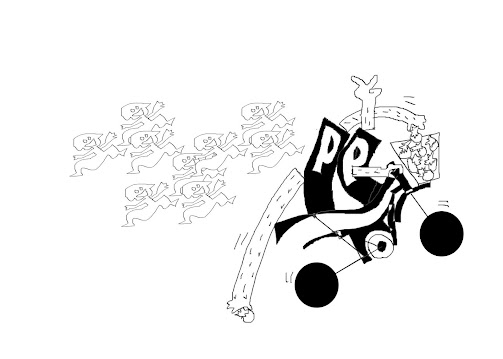
Man Winkler's contribution to the project , see blog entry, April 22
Little Remains After 40 Years of Scrap Hunters

Too big with rusted bolts for the recycling confirms you are on the Trail
Forest Fire

Sunset on Lao at the Viet Nam border. Imagine these skies on real fire 40 years ago.
Descendant of First Generation Clearance Team

Pigs, Dogs and Children were the first to clear UXOs before western conscience finally activated, see website
Jettisoned Fuel Tank Takes to the Air Again

B52s dropped their supplimentary fuel tanks after their deadly Cluster Bomb missions
UXO Lao Xekong meet Project Pineapple

Mr Tawee and some of his crew receiving COPE's brouchures
Mountain Villagers Have Little But The Land They Live On

Why should these people be suffering from the war remants so flagrantly scattered 40 years ago?
Complex Weaving Designs Take a Complex Comprehension

Villagers skilled in weaving intricate designs easily capable of searching their mountainous forest floor plan
Unstoppable Road Development of the Ho Chi Minh Trail

Parking a Minsk even for a moment can be hazardous
Minsk 125cc 2002
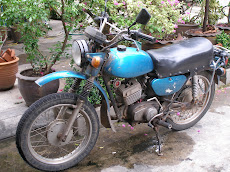
Your going on that? remarked Tony, the web man.
What's that Minsk doing up there?

It's on the way to my 'local' mechanic in Luang Prabang of course.
My 'Local' Mechanic
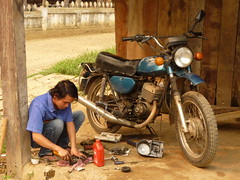
Hey Joe, Second Gear, not Top Gear
A Jarring Ride
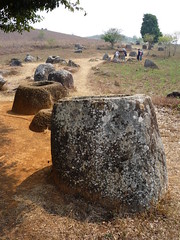
Phonsavan, Pathet Lao stronghold
Hanoi, Minsk's Second Fix

Snagging repairs after first fix
The Ride Kickstarts

Project Pineapple departs from Bach Mai Hospital, Hanoi
The Big House Pitstop

Not reaching the start of the Ho Chi Minh Trail on the first day we make a pitstop at this fine traditional Big House.
Cam Thuy, Start of the Ho Chi Minh Trail

Outside the restaurant, our last meal together before they head north and I south
Project Pineapple Riders

Ben from Australia, with 32 biking trophies to his name, rides the Minsk in Hanoi
Ho Chi Minh's Birth Place

Not far off the Trail to which he gave it's name, Uncle Ho's house
Phong Nga Cave's now Toothless Mouth

Like Venice, Cave Gondaleers have time
Spooked at Trail Crossroads

Tien with Jokers Alain and Ludivec
Moody Mountains of Mordor

The Spooky crossroads of the Trail
Friendly French

Missing a gear change causes a photo op returning to the caves
Chain of Events cause Delays

Tuan speedily replaces clutch and drive chain




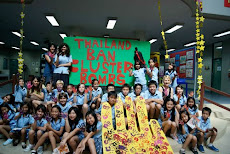


































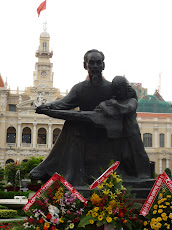















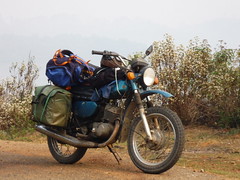







No comments:
Post a Comment